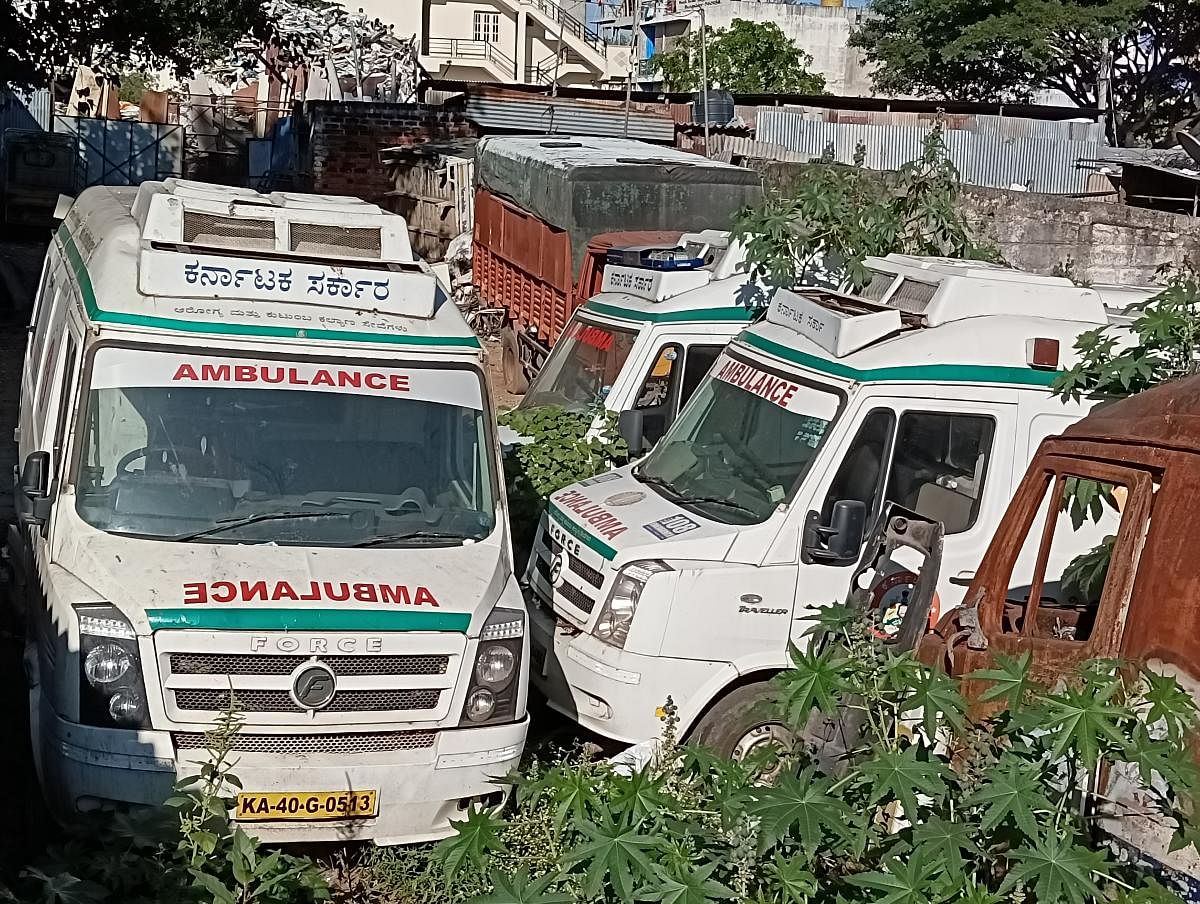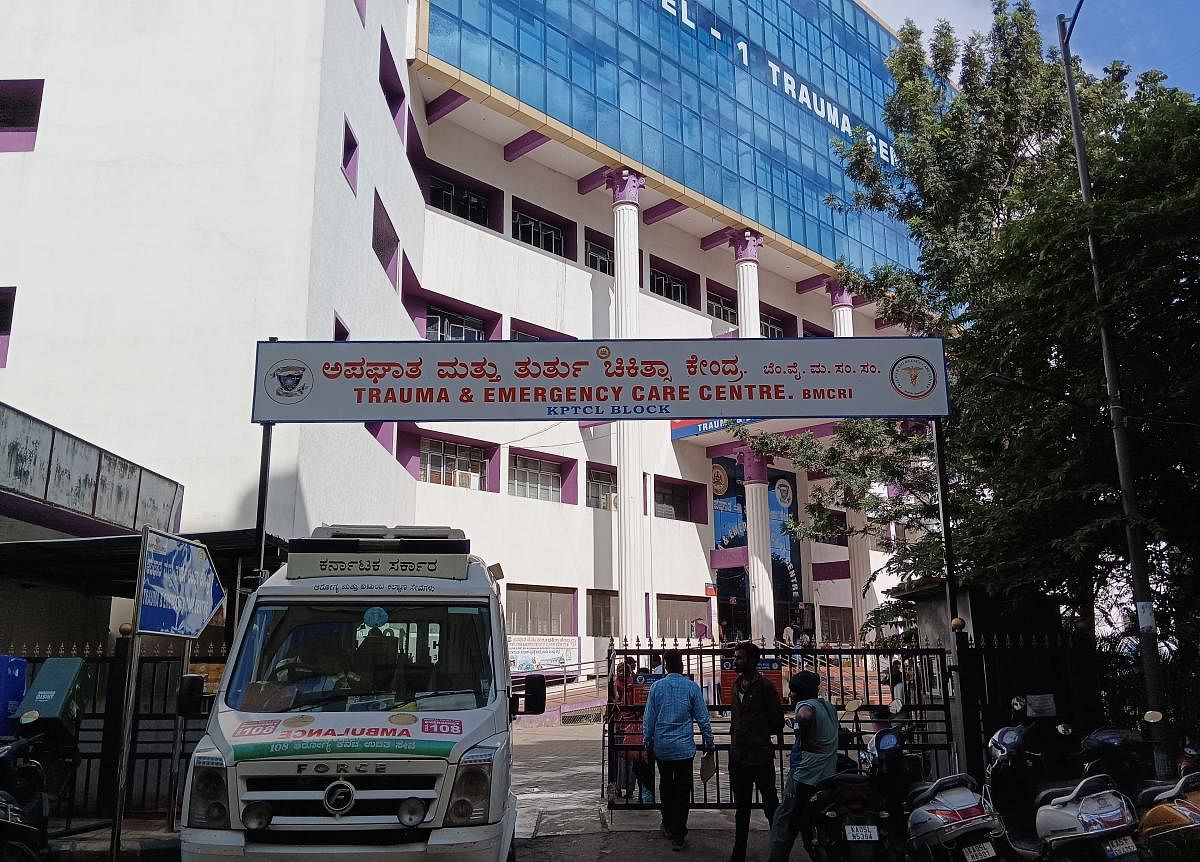

In front of the trauma care centre of Bangalore Medical College and Research Institute, a driver was struggling to start his Arogya Kavacha 108 ambulance.
When asked what was wrong, he opened up to reveal many problems faced by drivers (called pilots), and emergency medical technicians (EMTs) who work for the state government’s Arogya Kavacha free emergency medical service, currently run by the Hyderabad-based nonprofit GVK EMRI. This has now changed its name to EMRI Green Health Services.
The vehicles are not maintained properly, the driver said. This particular vehicle had run 20,000 km since the last time it was serviced. In the normal course, oil, air and diesel filters are changed every 8,000 km, he said.
Shrishail Hallur, president of Karnataka Rajya Arogya Kavacha 108 Naukarara Sangha, says many vehicles are stalled because of poor maintenance, a major problem being damaged tyres. Bengaluru has 89 vehicles, and officials say about 60 are working as of today.
A reality check by DH found 10 ambulances parked in a garage near Sumanahalli. Some had met with accidents and others had come in for routine service. The garage owner said they had been parked there for at least six months, and he was not repairing them. His reason: GVK owes him Rs 12 lakh for work undertaken previously, and he is waiting.
The problem with 108 ambulances began in 2016 when its staff demonstrated to highlight their problems. The contract with GVK EMRI expired in 2018. However, the government asked them to continue as the tender process was taking time. When the government finally floated tenders, there were no bidders.
Meanwhile, the computers installed in 2008 at the ambulance call centre crashed in September 2021, sending the state into panic. The systems were eventually upgraded and services were restored after four hours.
Bengaluru, being the capital hosting a sixth of the state’s population, gets better attention, but sources say the situation is dire in the rest of the state. Meanwhile, the new tender for the EMRI system has received no responses, and the re-tendering is yet to happen.
‘Salary still pending’
Another driver told DH two months’ salary was pending. "Every time the unions talk of a protest, the salary is paid, and then they don't pay for two-three months. We also have families and problems, we work to save lives but we don't belong to the government," he said.
He explained how drivers don’t even get a place to rest through their 12-hour shifts. Officials wash their hands of the problem by saying they have contracted everything out to the private entity.
"We don't belong to the company that has hired us, we don't have a regular salary date. How do we meet our financial commitments?" he asked.
Shrishaila Allur says the situation was worse. The pay was at Rs 9,000-12,000, until recently, and they got no increment for three years. Two months ago, they got a hike in minimum wages and a net increment of 45%. For 12 hours of duty, a pilot gets a minimum of Rs 26,000 a month and an EMT gets Rs 27,000, and more based on the service and seniority.
'Let govt take care of ambulance services'
Sources accuse the company of malpractice, overcharging the government and diverting funds to other uses. Sources say the government used to deposit an advance in quarterly instalments, but once the malpractice came to light, the government started paying against invoices. The process takes more time and as a result, payment also gets delayed, which also affects the salaries of pilots and EMTs.
DH reached out to GVK EMRI for comments but the spokesperson did not wish to speak.
N H Paramashiva, who says he heads another staff union, suggests that the government should run the emergency medical response system by setting up a KSRTC-like corporation. “The government has the call centres, vehicles, district and taluk health officers, medical staff and all facilities. The ambulance staff are ready to work for the government. Why should the government spend crores on a company that loots?” he says.
Shrishaila agrees that since ambulance services are an essential service, and since there is no response to the tender call, the government could run the service itself.
However, the government is not inclined to take up the responsibility. “Emergency care is a complicated service which involves pre-hospital care, call centre management, and more. The government cannot take it up on its own. It will need a separate corporation. The proposal to take up EMRI services was discussed at the additional secretary level years ago but was dropped after all pros and cons were considered,” says Dr Narayan, deputy director, EMRI 108.
Private players: Lion's share, focus on profit
The state had filed a compliance report to the Karnataka High Court in November 2022 in relation to a case. In the report, it said there were 12,107 ambulances in the state including private ones. While the EMRI system owns 730-odd vehicles, the rest are private vehicles.
Bengaluru has just 60 government ambulances, which are offered free of charge. Lakshmi K, CEO of Kumar Ambulance and a member of Akhila Karnataka Ambulance Association, puts the number of private ambulances in Bengaluru at 2,000-2,500. They are owned by about 40 companies.
In 2020, the government asked private ambulance companies to fit all ambulances with GPS and inform the traffic police in order to take traffic clearance. Two-wheelers, three-wheelers and e-rickshaws were exempted. Lakshmi said all emergency ambulances were now equipped with GPS and followed the protocol.
Corporatisation of ambulances
Stanplus, a Hyderabad-based company, runs Red Ambulance. It entered into agreements with big private hospitals as well as local ambulance companies and now dominates the private ambulance market in Bengaluru. The company website claims it has a fleet of 900 ambulances. Official spokespersons were unreachable for comment.
Red Ambulance is said to be liaising with big corporate companies in Bengaluru to have in-site vehicles to help in case of emergencies. Smitha Venkatesh, an occupational health and safety management system auditor, says corporates must be prepared for emergencies.
Under the Factories Act and Rules, a company with more than 2,000 workers should have a complete medical facility with a resident doctor and ambulances. Companies employing more than 500 workers should have an ambulance and paramedics. This reduces the lead time to provide first aid in case of injury.
“We have a large number of organisations with fewer than 500 employees. They go to external ambulance service providers and connectivity, availability and accountability become a big question mark. The SOS calls to the state-owned ambulance services never get connected. Private service providers do not have trained paramedics onboard always,” she says.
‘Equipment, paramedics important’
Dr N K Venkataramana, neurosurgeon and founder of a super-speciality hospital, says ambulances constitute an important component of pre-hospital care. “It is a general assumption that in an emergency, the patient should be treated in the hospital. It is not true. The care should begin right from the emergency scene and should be continued till the patient reaches the hospital,” he says.
If not, all the technology, skill, and efficiency of specialists may go waste even if the patient reaches the hospital. Therefore ambulances should be well equipped and have paramedics on board, he says. Many a time, despite charging the customers heavily, private ambulances do not have the essential equipment and trained staff.
“Ambulance owners must ensure the equipment is functioning and the vehicle is maintained well. The paramedics must be trained adequately and updated on current standards of treatment. Drivers must be skilled enough to negotiate the city’s traffic,” he explains.
‘Nexus affects patients’
A source who works at an NGO that provides free ambulance services to the poor says it is difficult for anyone to run ambulances without government support, as maintenance, insurance, staff salaries and fuel cost money, and a nominal amount is not out of place.
However, there are also allegations of an “ugly nexus” between hospitals and ambulance networks where cuts are given when ambulances bring in patients, especially in emergency cases. Also if people are from the outskirts of the city, and if they are not knowledgeable, the chances of them being taken for a ride are higher.
Many in the sector privately admit a ‘nexus’ exists, but no one talks about it on record. Unless such a nexus is broken, the practice of making money while patients are fighting for their lives will continue, the source says.